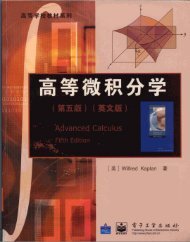Milne - Group Theory.. - Free
Milne - Group Theory.. - Free
Milne - Group Theory.. - Free
You also want an ePaper? Increase the reach of your titles
YUMPU automatically turns print PDFs into web optimized ePapers that Google loves.
18 2 FREE GROUPS AND PRESENTATIONS<br />
Proof. Let α be a map X → H. From the universal property of free groups (2.3),<br />
we know that α extends to a homomorphism FX → H, which we again denote α.<br />
Let ιR be the image of R in FX. By assumption ιR ⊂ Ker(α), and therefore the<br />
normal subgroup N generated by ιR is contained in Ker(α). Hence(seep11),α<br />
factors through FX/N = G. This proves the existence, and the uniqueness follows<br />
from the fact that we know the map on a set of generators for X.<br />
Example 2.10. Let G = 〈a, b|a n ,b 2 ,baba〉. We prove that G is isomorphic to D n .<br />
Because the elements σ, τ ∈ D n satisfy these relations, the map<br />
{a, b} →D n , a ↦→ σ, b ↦→ τ<br />
extends uniquely to a homomorphism G → D n . This homomorphism is surjective<br />
because σ and τ generate D n . The relations a n =1, b 2 =1, ba = a n−1 b<br />
imply that each element of G is represented by one of the following elements,<br />
1,...,a n−1 ,b,ab,...,a n−1 b, and so (G : 1) ≤ 2n = (D n : 1). Therefore the homomorphism<br />
is bijective (and these symbols represent distinct elements of G).<br />
Finitely presented groups<br />
A group is said to be finitely presented if it admits a presentation (X, R) withboth<br />
X and R finite.<br />
Example 2.11. Consider a finite group G. LetX = G, andletR be the set of words<br />
{abc −1 | ab = c in G}.<br />
I claim that (X, R) is a presentation of G, andsoG is finitely presented. Let G ′ =<br />
〈X|R〉. Th e map FX → G, a ↦→ a, sends eachelement of R to 1, and therefore<br />
defines a homomorphism G ′ → G, which is obviously surjective. But clearly every<br />
element of G ′ is represented by an element of X, and so the homomorphism is also<br />
injective.<br />
Although it is easy to define a group by a finite presentation, calculating the<br />
properties of the group can be very difficult — note that we are defining the group,<br />
which may be quite small, as the quotient of a huge free group by a huge subgroup.<br />
I list some negative results.<br />
The word problem<br />
Let G be the group defined by a finite presentation (X, R). The word problem for<br />
G asks whether there is an algorithm (decision procedure) for deciding whether a<br />
word on X ′ represents 1 in G. Unfortunately, the answer is negative: Novikov and<br />
Boone showed that there exist finitely presented groups G for which there is no such<br />
algorithm. Of course, there do exist other groups for which there is an algorithm.<br />
The same ideas lead to the following result: there does not exist an algorithm that<br />
will determine for an arbitrary finite presentation whether or not the corresponding

















